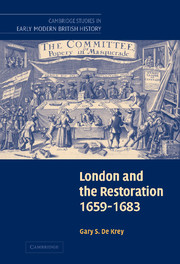Book contents
- Frontmatter
- Contents
- List of figures
- Map
- List of tables
- Preface
- List of abbreviations
- Part I Crisis, 1659–1660
- Part II Settlement and unsettlement, 1660–1679
- Part III Crisis, 1679–1682
- Introduction: London and the Restoration crisis, 1679–1682
- 4 Parliament and Protestantism in crisis: the emergence of parties in London, 1679–1681
- 5 The contest for the city, 1681–1682
- 6 Party matters: communities, ideas, and leaders in a divided city, 1679–1682
- Part IV Crisis and conspiracy, 1682–1683
- Conclusion: London and the end of the Restoration
- Appendices
- Appendix I 1670 London dissenting subscription
- Appendix II London dissenting common councilmen, 1669–1671
- Appendix III Whig party leaders
- Appendix IV Tory party leaders
- Bibliography
- Index
- Titles in the series
Introduction: London and the Restoration crisis, 1679–1682
Published online by Cambridge University Press: 07 May 2010
- Frontmatter
- Contents
- List of figures
- Map
- List of tables
- Preface
- List of abbreviations
- Part I Crisis, 1659–1660
- Part II Settlement and unsettlement, 1660–1679
- Part III Crisis, 1679–1682
- Introduction: London and the Restoration crisis, 1679–1682
- 4 Parliament and Protestantism in crisis: the emergence of parties in London, 1679–1681
- 5 The contest for the city, 1681–1682
- 6 Party matters: communities, ideas, and leaders in a divided city, 1679–1682
- Part IV Crisis and conspiracy, 1682–1683
- Conclusion: London and the end of the Restoration
- Appendices
- Appendix I 1670 London dissenting subscription
- Appendix II London dissenting common councilmen, 1669–1671
- Appendix III Whig party leaders
- Appendix IV Tory party leaders
- Bibliography
- Index
- Titles in the series
Summary
The Restoration began in one great crisis about parliamentary government and Protestantism, and it concluded in another. In 1659–60, most Reformed Protestants had come to agree with their Anglican counterparts that the restoration of monarchy was the best means to secure parliament and the Protestant establishment. But by 1679–82, many of those same Reformed Protestants had come to agree with their onetime sectarian adversaries that the episcopal leadership of the church and the prospect of a Catholic successor endangered both Protestantism and parliament again. The greatest beneficiary of the first crisis, Charles II survived the crisis of 1679–82 through a combination of good luck and good wit.
Recent scholars have followed contemporaries and Whig historians in dwelling upon the importance of London to the crisis that overtook the kingdom in 1679. But the traditional account of the crisis has been pulled apart as historians have engaged in an extensive process of demythologizing directed at the conventions of Whig historiography. Scholarly fragmentation has replaced the comfortable consensus that prevailed into the 1980s. Almost every feature of the Whig interpretation of the “Exclusion Crisis” has been challenged by one historian or another.
Tim Harris has demonstrated the fallacy of the whiggish assumption that ordinary people in London naturally identified with opposition to the Court: instead, according to him, the variety of perspectives that flourished amongst the menu peuple inclined them to both sides of the divide between Charles II and his critics.
- Type
- Chapter
- Information
- London and the Restoration, 1659–1683 , pp. 169 - 173Publisher: Cambridge University PressPrint publication year: 2005



